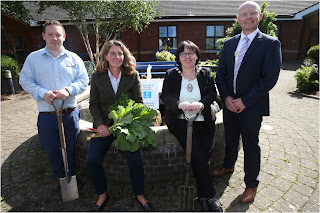How we bucked the UK's disastrous butterfly trend
This summer has been a disaster for butterflies across the UK - but actually it’s been a better picture in Northern Ireland.
The results of the Big Butterfly Count reveal that most butterfly species studied in the huge citizen science scheme saw populations fall across the UK, with some producing their worst numbers since the count began.
But in Northern Ireland, most species showed improvements on the cold wet summer of 2015.
Northern Ireland observers saw an average of 11 individual butterflies per count, a big improvement on just eight per count in 2015.
The overall UK average in this summer’s Big Butterfly Count was the lowest since the citizen science project began (with an average of just 12 butterflies spotted per count).
In Northern Ireland the Ringlet was, once again, the most commonly seen butterfly, up 12% in comparison to last year - but it was the common white butterflies that really stole the show.
The Green-veined White proved to be the most abundant of these and its population increased by 184% in comparison to last year.
The Large White saw its numbers rise by 109% and Small White also experienced an increase of 77%.
The Six-spot Burnet, a colourful day flying moth ,also enjoyed a good year with numbers up 265% year on year.
But one common species, the Small Tortoiseshell struggled, with numbers falling 55% in comparison to last summer.
The Small Tortoiseshell has now decreased almost six-fold over three years in Northern Ireland, falling from an average of three per count in the summer of 2013 to only 0.5 per count this summer.
The scarce Holly Blue also dropped back after a particularly good year in 2015.
Low butterfly numbers across the UK come despite the summer of 2016 being warmer than average and relatively dry – conditions butterflies typically depend upon in order to successfully breed and feed.
The reasons why butterflies have struggled despite those favourable summer weather conditions are as yet unclear.
Butterfly Conservation’s Head of Recording, Richard Fox, said: “The drop in butterfly numbers across the UK as a whole this summer has been a shock and is a bit of a mystery. When we have cold, wet summers, as in 2012, we expect butterfly populations to plummet, but that can’t have been the case this year.
“The summer months were warmer than usual, yet most Big Butterfly Count participants saw fewer butterflies. Perhaps the very mild winter had a negative effect, or the cold spring, or perhaps the impacts of intensive farming and pesticides are really hitting these common species now.
“It was good to see many widespread species bounce back in Northern Ireland after the terrible summer in 2015. Although the results here bucked the wider UK-trend, it was not a vintage summer for butterflies – many species were seen in lower numbers than in 2013 and 2014.
“The importance of Big Butterfly Count is that it takes place every year over a long period; the longer it goes on the more we can learn about the causes that are driving the declines and in some cases, increases of our beautiful butterfly species.
“We are really grateful to the many thousands of people across the UK who do their bit to help butterflies by taking part in the Big Butterfly Count each summer.”
Butterfly Conservation Senior Officer in Northern Ireland Catherine Bertrand, said: “It is good to see many widespread species bounce back here after the terrible summer of 2015.
“Although our results bucked the wider UK trend it was not a vintage summer for butterflies – many species were seen in lower numbers than 2013 and 2014.”
More than 36,000 people took part in this year’s count, spotting around 390,000 butterflies across the UK during the three-week mid-summer recording period.
The Big Butterfly Count helps Butterfly Conservation find out how the UK’s common species are faring and how to best protect them in the future.
Results can be found at www.bigbutterflycount.org.
Big Butterfly Count 2016 – top 10 NI species ranking
- Ringlet
- Green-veined White
- Meadow Brown
- Six-spot Burnet
- Small White
- Small Tortoiseshell
- Common Blue
- Large White
- Speckled Wood
- Red Admiral



linda thank you SO SO SO much for reporting on things like this, its just so important to get proper news thank you xxx
ReplyDeleteAw thank you! I assumed it would have been in all the papers already, but it wasn't!
Delete